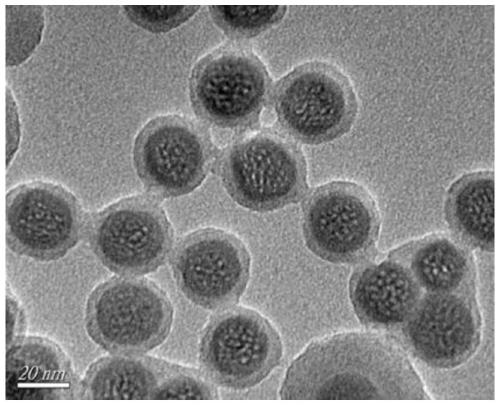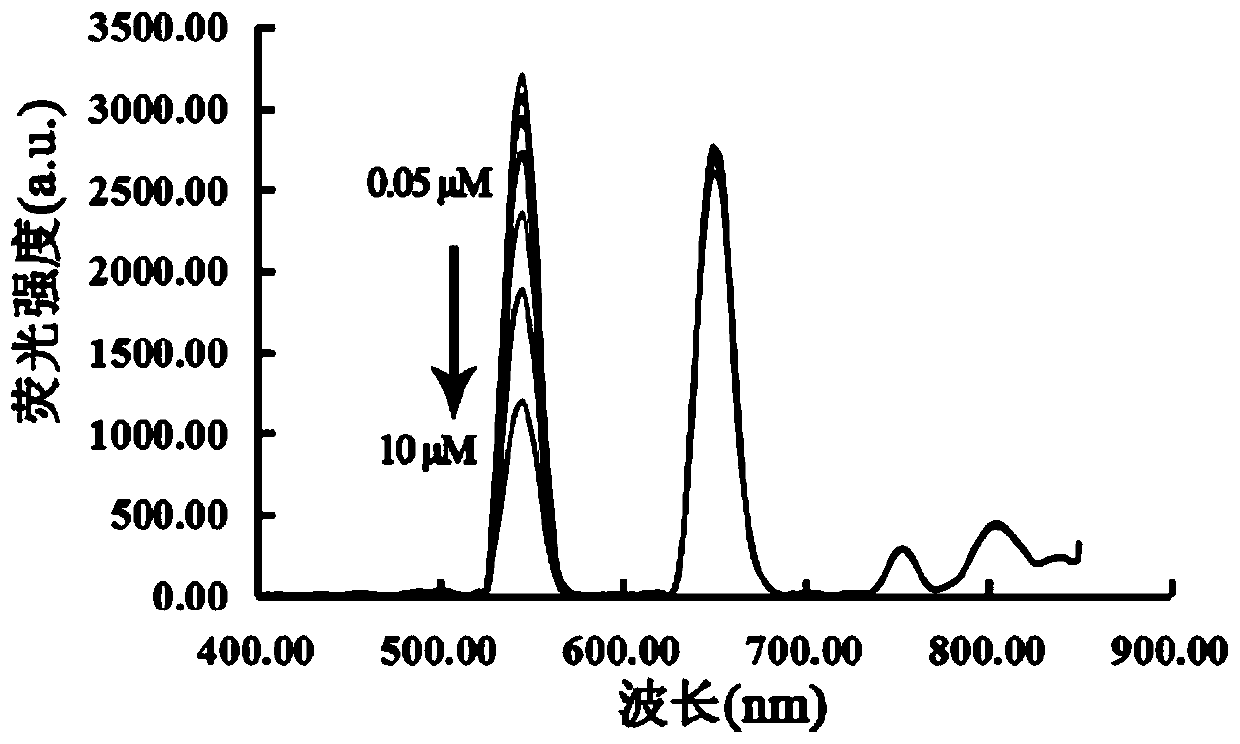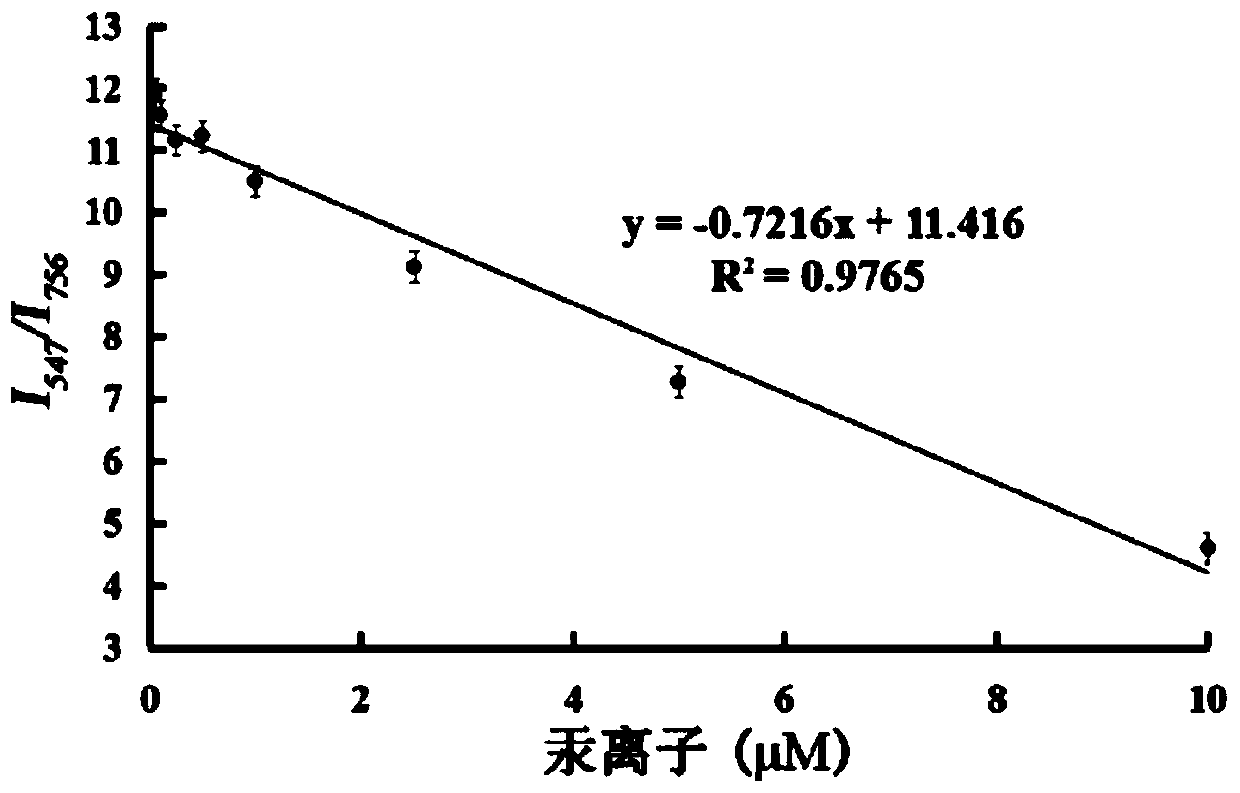A detection method for mercury content in tea based on upconversion and rhodamine derivative specific system
A detection method and derivative technology, applied in the field of food safety detection, can solve the problems of long detection time, high detection cost, cumbersome detection steps, etc., and achieve the effects of wide linear detection range, high sensitivity detection, high detection accuracy and sensitivity
- Summary
- Abstract
- Description
- Claims
- Application Information
AI Technical Summary
Problems solved by technology
Method used
Image
Examples
Embodiment 1
[0034] The invention discloses a method for detecting mercury content in tea based on an up-conversion and rhodamine derivative specific system. The specific steps are as follows:
[0035] Step 1, preparation of up-conversion nanomaterials: Accurately weigh 0.087g of yttrium chloride hexahydrate, 0.047g of ytterbium chloride hexahydrate, 0.005g of holmium chloride hexahydrate and 0.066g of gadolinium chloride hexahydrate, and ultrasonically dissolve them with 3mL of methanol 5min, transfer to a 250mL three-necked flask, add 4.5mL oleic acid and 10.5mL 1-octadecene; under the protection of argon, heat to 160°C for the first time, magnetically stir for 30min, cool to room temperature; Add 15mL of methanol solution containing 0.221g of ammonium fluoride and 0.45g of sodium hydroxide dropwise into the solution, then react in the first water bath at 50°C for 30min, and in the second water bath at 80°C for 40min, to completely volatilize the methanol in the solution; , under argon p...
Embodiment 2
[0045] The invention discloses a method for detecting mercury content in tea based on an up-conversion and rhodamine derivative specific system. The specific steps are as follows:
[0046] Step 1, preparation of up-conversion nanomaterials: Accurately weigh 0.087g of yttrium chloride hexahydrate, 0.047g of ytterbium chloride hexahydrate, 0.005g of holmium chloride hexahydrate and 0.066g of gadolinium chloride hexahydrate, and ultrasonically dissolve them with 3mL of methanol 10min, transfer to a 250mL three-necked flask, add 4.5mL oleic acid and 10.5mL 1-octadecene; under the protection of argon, heat to 150°C for the first time, magnetically stir for 30min, cool to room temperature; Add 15mL of methanol solution containing 0.221g of ammonium fluoride and 0.45g of sodium hydroxide dropwise into the solution, then react in the first water bath at 45°C for 30min, and then react in the second water bath at 85°C for 40min to completely volatilize the methanol in the solution; , un...
Embodiment 3
[0054] The invention discloses a method for detecting mercury content in tea based on an up-conversion and rhodamine derivative specific system. The specific steps are as follows:
[0055] Step 1, preparation of up-conversion nanomaterials: Accurately weigh 0.087g of yttrium chloride hexahydrate, 0.047g of ytterbium chloride hexahydrate, 0.005g of holmium chloride hexahydrate and 0.066g of gadolinium chloride hexahydrate, and ultrasonically dissolve them with 3mL of methanol 8min, transfer to a 250mL three-necked flask, add 4.5mL oleic acid and 10.5mL 1-octadecene; under the protection of argon, heat to 170°C for the first time, magnetically stir for 30min, cool to room temperature; Add 15mL of methanol solution containing 0.221g of ammonium fluoride and 0.45g of sodium hydroxide dropwise to the solution, then react in the first water bath at 55°C for 30min, and then react in the second water bath at 75°C for 40min to completely volatilize the methanol in the solution; then, U...
PUM
| Property | Measurement | Unit |
|---|---|---|
| concentration | aaaaa | aaaaa |
| concentration | aaaaa | aaaaa |
Abstract
Description
Claims
Application Information
 Login to View More
Login to View More - R&D
- Intellectual Property
- Life Sciences
- Materials
- Tech Scout
- Unparalleled Data Quality
- Higher Quality Content
- 60% Fewer Hallucinations
Browse by: Latest US Patents, China's latest patents, Technical Efficacy Thesaurus, Application Domain, Technology Topic, Popular Technical Reports.
© 2025 PatSnap. All rights reserved.Legal|Privacy policy|Modern Slavery Act Transparency Statement|Sitemap|About US| Contact US: help@patsnap.com



